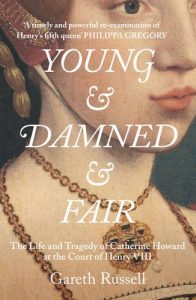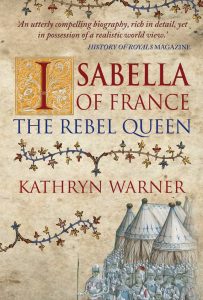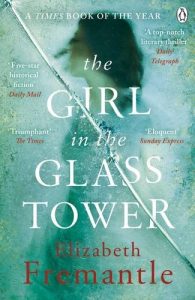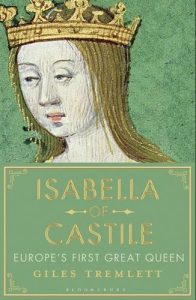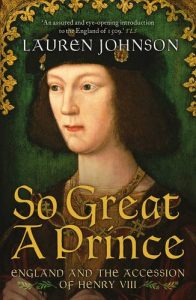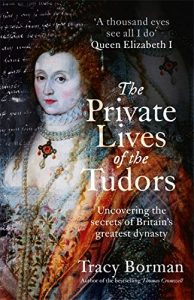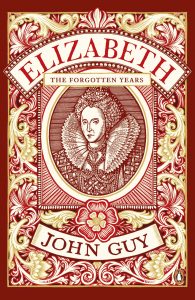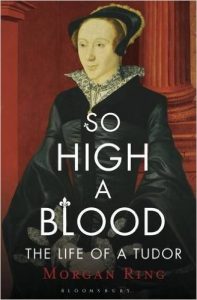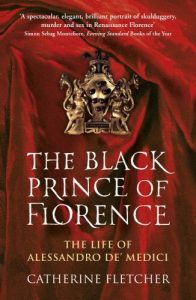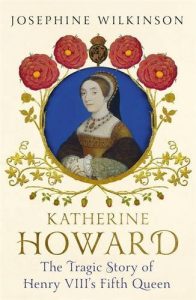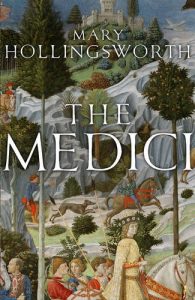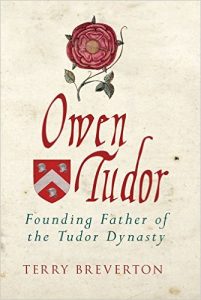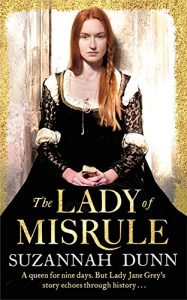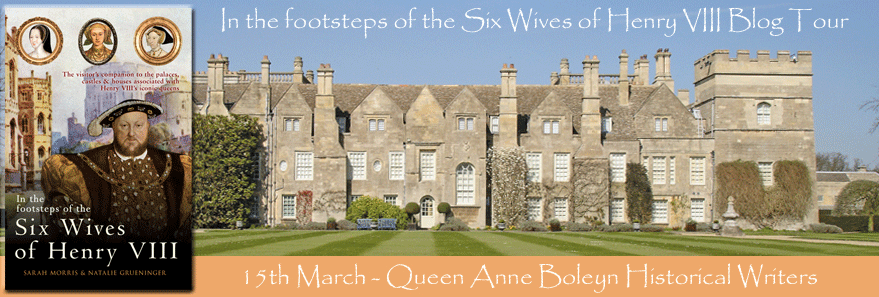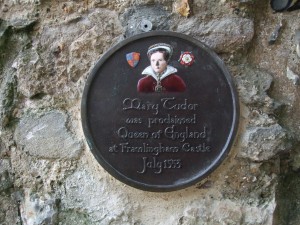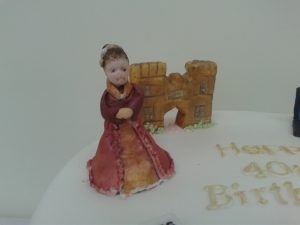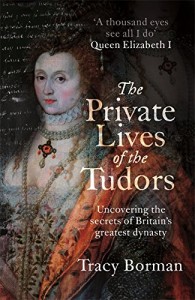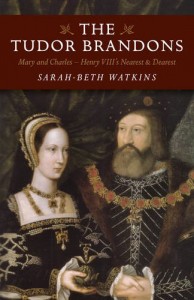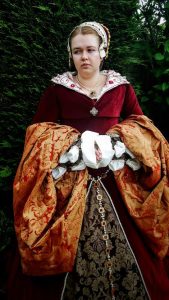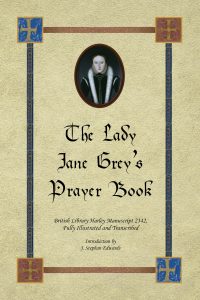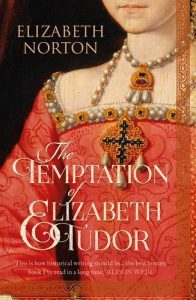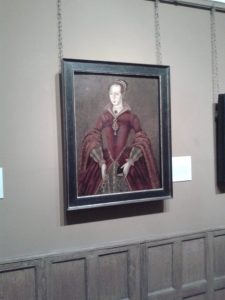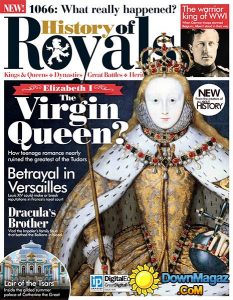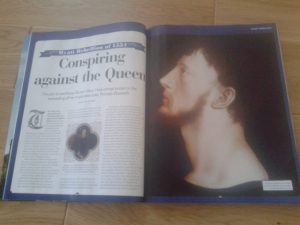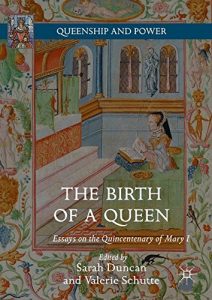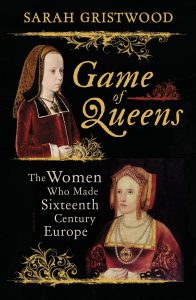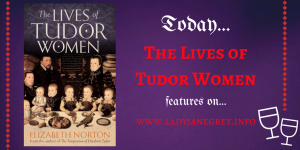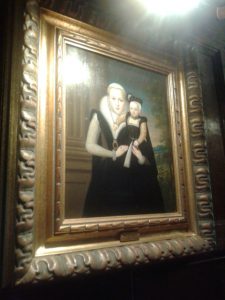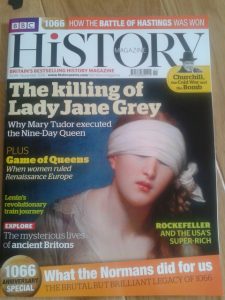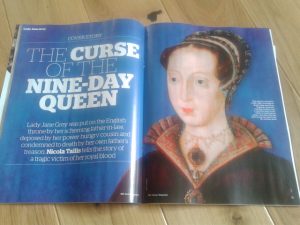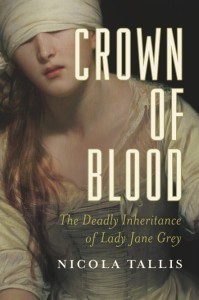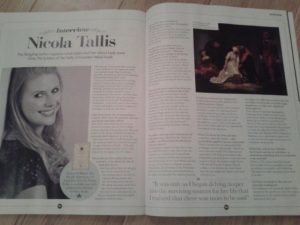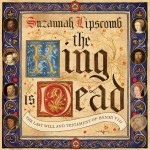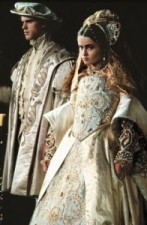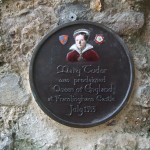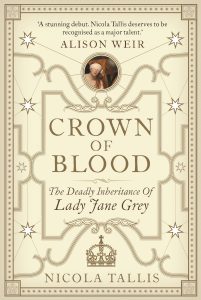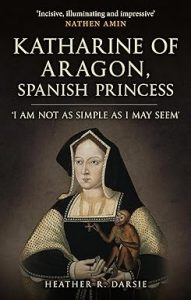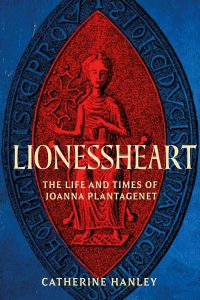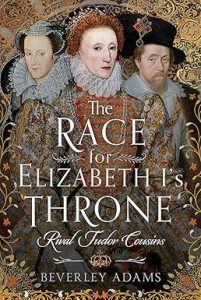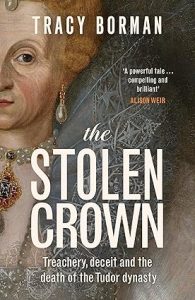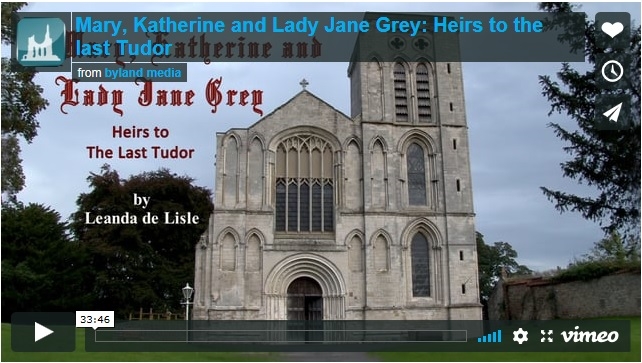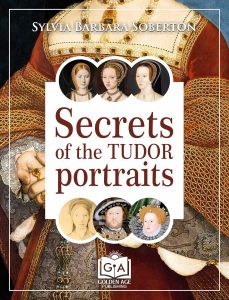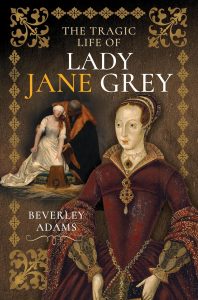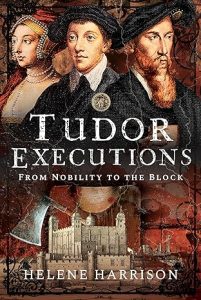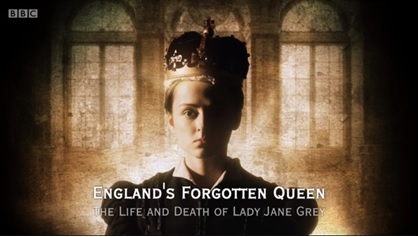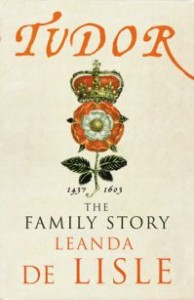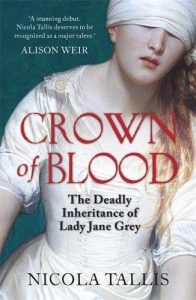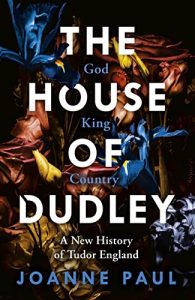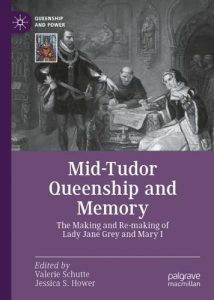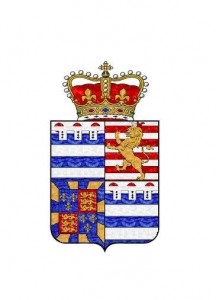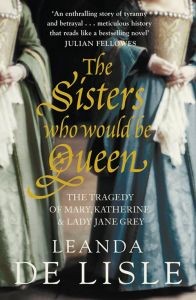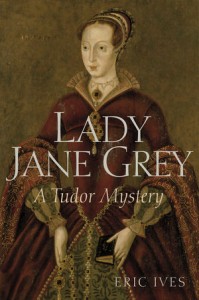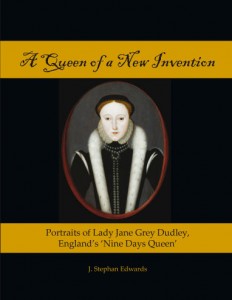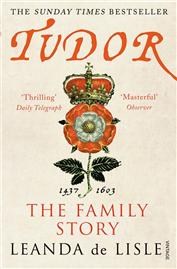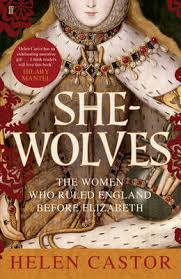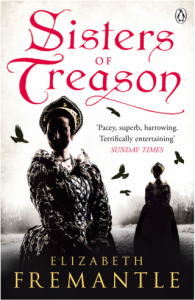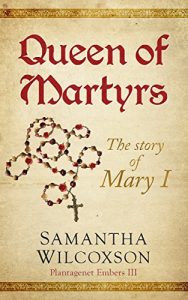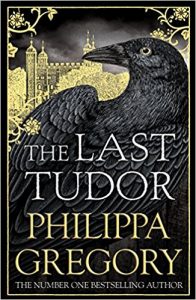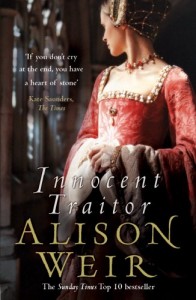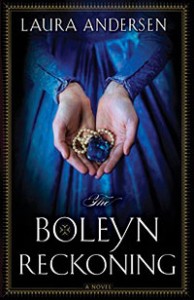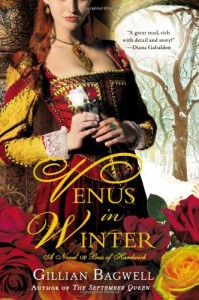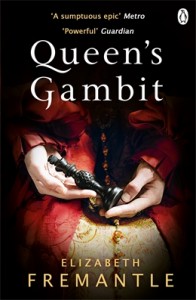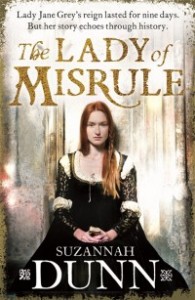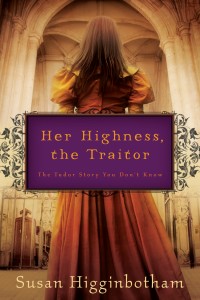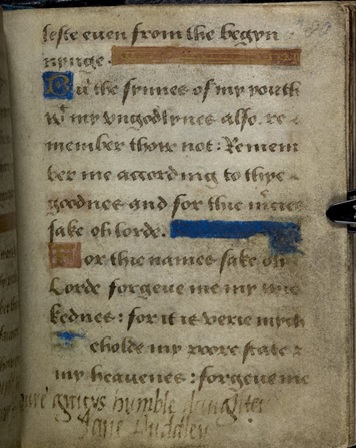12th January 2017 – Young and Damned and Fair: The Life and Tragedy of Catherine Howard at the Court of Henry VIII by Gareth Russell
‘England July 1540: it is one of the hottest summers on record and the court of Henry VIII is embroiled, once again, in political scandal. Anne Cleves is out. Thomas Cromwell is to be executed and, in the countryside, an aristocratic teenager named Catherine Howard prepares to become fifth wife to the increasingly unpredictable monarch…
In the five centuries since her death, Catherine Howard has been dismissed as ‘a wanton’, ‘inconsequential’ or a naïve victim of her ambitious family, but the story of her rise and fall offers not only a terrifying and compelling story of an attractive, vivacious young woman thrown onto the shores of history thanks to a king’s infatuation, but an intense portrait of Tudor monarchy in microcosm: how royal favour was won, granted, exercised, displayed, celebrated and, at last, betrayed and lost. The story of Catherine Howard is both a very dark fairy tale and a gripping political scandal.
Born into the nobility and married into the royal family, during her short life Catherine was almost never alone. Attended every waking hour by servants or companions, secrets were impossible to keep. With his research focus on Catherine’s household, Gareth Russell has written a narrative that unfurls as if in real-time to explain how the queen’s career ended with one of the great scandals of Henry VIII’s reign.
More than a traditional biography, this is a very human tale of some terrible decisions made by a young woman, and of complex individuals attempting to survive in a dangerous hothouse where the odds were stacked against nearly all of them. By illuminating Catherine’s entwined upstairs/downstairs worlds, and bringing the reader into her daily milieu, the author re-tells her story in an exciting and engaging way that has surprisingly modern resonances and offers a fresh perspective on Henry’s fifth wife.
YOUNG AND DAMNED AND FAIR is a riveting account of Catherine Howard’s tragic marriage to one of history’s most powerful rulers. It is a grand tale of the Henrician court in its twilight, a glittering but pernicious sunset during which the king’s unstable behaviour and his courtiers’ labyrinthine deceptions proved fatal to many, not just to Catherine Howard.’
Further details – Amazon.co.uk
15th January 2017 – Isabella of France: The Rebel Queen (paperback) by Kathryn Warner
‘Isabella of France married Edward II in January 1308, and afterwards became one of the most notorious women in English history. In 1325, she was sent to her homeland to negotiate a peace settlement between her husband and her brother Charles IV, king of France. She refused to return. Instead, she began a relationship with her husband’s deadliest enemy, the English baron Roger Mortimer. With the king’s son and heir, the future Edward III, under their control, the pair led an invasion of England which ultimately resulted in Edward II’s forced abdication in January 1327. Isabella and Mortimer ruled England during Edward III’s minority until he overthrew them in October 1330.
A rebel against her own husband and king, and regent for her son, Isabella was a powerful, capable and intelligent woman. She forced the first ever abdication of a king in England, and thus changed the course of English history. Examining Isabella’s life with particular focus on her revolutionary actions in the 1320s, this book corrects the many myths surrounding her and provides a vivid account of this most fascinating and influential of women.’
Further details – Amazon.co.uk
9th February 2017 – The Girl in the Glass Tower (paperback) by Elizabeth Fremantle
‘Tap. Tap. Tap on the window.
Something, someone wanting to be heard. Waiting to be free.
Tudor England. The word treason is on everyone’s lips. Arbella Stuart, niece to Mary, Queen of Scots and presumed successor to Elizabeth I, has spent her youth behind the towering windows of Hardwick Hall. As presumed successor to the throne, her isolation should mean protection – but those close to the crown are never safe.
Aemilia Lanyer – writer and poet – enjoys an independence denied to Arbella. Their paths should never cross. But when Arbella enlists Aemilia’s help in a bid for freedom, she risks more than her own future. Ensnared in another woman’s desperate schemes, Aemilia must tread carefully or share her terrible fate . . .
The Girl in the Glass Tower brilliantly explores what it means to be born a woman in a man’s world, where destiny is strictly controlled and the smallest choices may save – or destroy – us.’
Further details – Amazon.co.uk
9th February 2017 – Isabella of Castile: Europe’s First Great Queen (paperback) by Giles Tremlett
’ In 1474, a twenty-three year old woman ascended the throne of Castile, the largest and strongest kingdom in Spain. Ahead of her lay the considerable challenge not only of being a young, female ruler in an overwhelmingly male-dominated world, but also of reforming a major European kingdom that was riddled with crime, corruption, and violent political factionism. Her marriage to Ferdinand of Aragon was crucial to her success, bringing together as it did two kingdoms, but it was a royal partnership in which Isabella more than held her own. Her pivotal reign was long and transformative, uniting Spain and setting the stage for its golden era of global dominance. For by the time of her death in 1504, Isabella had laid the foundations not just of modern Spain, but of one of the world’s greatest empires. Acclaimed historian Giles Tremlett chronicles the life of Isabella of Castile as she led her country out of the murky middle ages and harnessed the newest ideas and tools of the early Renaissance to turn her ill-disciplined, quarrelsome nation into a sharper, modern state with a powerful, clear-minded, and ambitious monarch at its centre. With authority, insight and flair he relates the story of this legendary, if controversial, first initiate in a small club of great European queens that includes Elizabeth I of England, Russia’s Catherine the Great, and Britain’s Queen Victoria.’
Further details – Amazon.co.uk
9th February – So Great a Prince: England and the Accession of Henry VIII (paperback) by Lauren Johnson
‘The King is dead: long live the King. In 1509, Henry VII was succeeded by his son Henry VIII, second monarch of the house of Tudor. But this is not the familiar Tudor world of Protestantism and playwrights. Decades before the Reformation, ancient traditions persist: boy bishops, pilgrimage, Corpus Christi pageants, the jewel-decked shrine at Canterbury.
So Great a Prince offers a fascinating glimpse of a country and people that at first appear alien – in calendar and clothing, in counting the hours by bell toll – but which on closer examination are recognisably and understandably human. Lauren Johnson tells the story of 1509 not just from the perspective of king and court, but of merchant and ploughman; apprentice and laundress; husbandman and foreign worker. She looks at these early Tudor lives through the rhythms of the ritual year, juxtaposing political events in Westminster and the palaces of southeast England with the liturgical and agricultural events that punctuated the year for the ordinary people of England.’
9th March 2017 – The Private Lives of the Tudors: Uncovering the Secrets of Britain’s Greatest Dynasty (paperback) by Tracy Borman
‘I do not live in a corner. A thousand eyes see all I do.’ Elizabeth I
The Tudor monarchs were constantly surrounded by an army of attendants, courtiers and ministers. Even in their most private moments, they were accompanied by a servant specifically appointed for the task. A groom of the stool would stand patiently by as Henry VIII performed his daily purges, and when Elizabeth I retired for the evening, one of her female servants would sleep at the end of her bed.
These attendants knew the truth behind the glamorous exterior. They saw the tears shed by Henry VII upon the death of his son Arthur. They knew the tragic secret behind ‘Bloody’ Mary’s phantom pregnancies. And they saw the ‘crooked carcass’ beneath Elizabeth I’s carefully applied makeup, gowns and accessories.
It is the accounts of these eyewitnesses, as well as a rich array of other contemporary sources that historian Tracy Borman has examined more closely than ever before. With new insights and discoveries, and in the same way that she brilliantly illuminated the real Thomas Cromwell – The Private Life of the Tudors will reveal previously unexamined details about the characters we think we know so well.’
Further details – Amazon.co.uk
30th March 2017 – Elizabeth: The Forgotten Years (paperback) by John Guy
‘History has pictured Elizabeth I as Gloriana, an icon of strength and power — and has focused on the early years of her reign. But in 1583, when Elizabeth is fifty, there is relentless plotting among her courtiers — and still to come is the Spanish Armada and the execution of Mary, Queen of Scots. We have not, until now, had the full picture.
This gripping and vivid portrait of her life and times — often told in her own words (and including details such as her love of chess and marzipan) — reveals a woman who was insecure, human (‘You know I am no morning woman’), and unpopular even with the men who fought for her. This is the real Elizabeth, for the first time.’
Further details – Amazon.co.uk
6th April 2017 – So High a Blood: The Life of Margaret, Countess of Lennox by Morgan Ring
‘’Who hopes still constantly with patience shall obtain victory in their claim’
Sometime heir to the English throne, courtier in danger of losing her head, spy-mistress and would-be architect of a united Catholic Britain: Lady Margaret Douglas is the Tudor whose life demands a wider telling.
As niece to Henry VIII and half-sister to James V of Scotland, the beautiful and Catholic Margaret held a unique and precarious position in the English court. Throughout her life, she was to navigate treacherous waters: survival necessitated it. Yet Margaret was no passive pawn or bit-part player. As the Protestant Reformations unfolded across the British Isles and the Tudor monarchs struggled to produce heirs, she had ambitions of her own. She wanted to see her family ruling a united, Catholic Britain. When her niece Mary, Queen of Scots was left a widow, Margaret saw her chance. Through a thoroughly Machiavellian combination of timing, networking and family connections, she set in motion a chain of shattering events that would one day see her descendants succeed to the crowns of England, Ireland and Scotland.
Morgan Ring has revived the story of Lady Margaret Douglas to vivid and captivating effect. From a richly detailed backdrop of political and religious turbulence Margaret emerges, full of resilience, grace and intelligence. Drawing on previously unexamined archival sources, So High a Blood presents a fascinating and authoritative portrait of a woman with the greatest of ambitions for her family, her faith and her countries.’
Further details – Amazon.co.uk
20th April 2017 – The Black Prince of Florence: The Spectacular Life and Treacherous World of Alessandro de’ Medici (paperback) by Catherine Fletcher
‘In The Black Prince of Florence, a dramatic tale of assassination, spies and betrayal, the first retelling of Alessandro’s life in two-hundred years opens a window onto the opulent, cut-throat world of Renaissance Italy.
The year is 1531. After years of brutal war and political intrigue, the bastard son of a Medici Duke and a ‘half-negro’ maidservant rides into Florence. Within a year, he rules the city as its Prince. Backed by the Pope and his future father-in-law the Holy Roman Emperor, the nineteen-year-old Alessandro faces down bloody family rivalry and the scheming hostility of Italy’s oligarchs to reassert the Medicis’ faltering grip on the turbulent city-state. Six years later, as he awaits an adulterous liaison, he will be murdered by his cousin in another man’s bed.
From dazzling palaces and Tuscan villas to the treacherous backstreets of Florence and the corridors of papal power, the story of Alessandro’s spectacular rise, magnificent reign and violent demise takes us deep beneath the surface of power in Renaissance Italy – a glamorous but deadly realm of spies, betrayal and vendetta, illicit sex and fabulous displays of wealth, where the colour of one’s skin meant little but the strength of one’s allegiances meant everything.’
Further details – Amazon.co.uk
20th April 2017 – Katherine Howard: The Tragic Story of Henry VIII’s Fifth Queen (paperback) by Josephine Wilkinson
‘Looming out of the encroaching darkness of the February evening was London Bridge, still ornamented with the severed heads of Thomas Culpeper and Francis Dereham; the terrible price they had paid for suspected intimacy with the queen.
Katherine now reached the Tower of London, her final destination.
Katherine Howard was the fifth wife of Henry VIII and cousin to the executed Anne Boleyn. She first came to court as a young girl of fourteen, but even prior to that her fate had been sealed and she was doomed to die. She was beheaded in 1542 for crimes of adultery and treason, in one of the most sensational scandals of the Tudor age.
The traditional story of Henry VIII’s fifth queen dwells on her sexual exploits before she married the king, and her execution is seen as her just dessert for having led an abominable life. However, the true story of Katherine Howard could not be more different.
Far from being a dark tale of court factionalism and conspiracy, Katherine’s story is one of child abuse, family ambition, religious conflict and political and sexual intrigue. It is also a tragic love story. A bright, kind and intelligent young woman, Katherine was fond of clothes and dancing, yet she also had a strong sense of duty and tried to be a good wife to Henry. She handled herself with grace and queenly dignity to the end, even as the barge carrying her on her final journey drew up at the Tower of London, where she was to be executed for high treason.
Little more than a child in a man’s world, she was the tragic victim of those who held positions of authority over her, and from whose influence she was never able to escape.’
Further details – Amazon.co.uk
4th May 2017 – The Lost Prince by Sarah Fraser
‘Henry Stuart’s life is last great forgotten Jacobean tale. Shadowed by the gravity of the Thirty Years’ War and the huge changes taking place across Europe in seventeenth century society, economy, politics and empire, his life was visually and verbally gorgeous.
Charismatic, gifted, dynamic – dead at only eighteen years old, on the point of succeeding to the throne.
In 1610, Henry Stuart was a celebrity throughout Europe, at a momentous period for European history and culture. Eldest son of James VI and the epitome of heroic Renaissance princely virtue, his life was set against a period about as rich as any. The King James Bible, religious tension throughout Europe, Gunpowder plot, Jacobean theatre and the dark tragedies pouring from Shakespeare’s quill, innovation in learning and science, exploration and trade – as well and the bloody traumas of the Thirty Years War were his backdrop. The Lost Prince tells the life story of the prince, now completely forgotten, who might have saved us from King Charles I, his spaniels and the civil war his misrule engendered.’
Further details – Amazon.co.uk
13th July 2017 – The Medici by Mary Hollingsworth
‘Having founded the bank that became the most powerful in Europe in the 15th century, the Medici gained political power in Florence, ruling the city during its cultural heyday and becoming its hereditary dukes. Among their number were no fewer than three popes, and a powerful and influential queen of France. Their patronage of the arts facilitated an explosion of Florentine art and architecture. Michelangelo, Donatello, Fra Angelico and Leonardo da Vinci are among the artists with which they were associated.
Thus runs the ‘received view’ of the Medici dukes of Florence. Mary Hollingsworth argues that this sanitized version – that they were wise rulers and enlightened patrons of the arts, fathers of the Renaissance – is a fiction devised by later generations who reinvented their past to create a myth that now has the status of historical fact. In truth, the Medici were as devious and immoral as the infamous Borgias, tyrants loathed in the city they illegally made their own and which they beggared in their lust for power.’
Further details – Amazon.co.uk
15th July 2017 – Owen Tudor: Founding Father of the Tudor Dynasty by Terry Breverton
‘For generations, the ancestors of Welshmen Owen Tudor had fought Romans, Irish Picts, Vikings, Saxons, Mercians and Normans. His uncles had been executed in the Glyndwr Welsh War of Independence, his father pardoned, but his estates stripped from him. Owen’s now landless father took him to London to try and find employment, and Owen fought for Henry V in France. He entered the service of Henry’s queen, Catherine of Valois, and soon after the king’s death he secretly married her, the mother of the 8-month-old Henry VI. Owen and Catherine would have two boys together, hidden from the world and the boy-king Henry VI by the Bishops of London and Ely. Henry VI would go on to ennoble them as Edmund Earl of Richmond, and Jasper Earl of Pembroke, but upon Catherine’s death Owen was imprisoned. Escaping twice, Owen was thrown into the beginnings of the Wars of the Roses with his two sons. Edmund died in Wales, and Jasper became the only lord who fought throughout the civil wars until his nephew, Edmund’s son Henry Tudor, was established on the English throne as Henry VII. When Jasper led the Lancastrian forces at Mortimer’s Cross in 1461, the aging Owen led a wing of the defeated army, was captured and executed. Without the secret marriage for love, there would have been no Tudor dynasty.’
Further details – Amazon.co.uk
10th August – The Last Tudor by Philippa Gregory
Further details – Amazon.co.uk
31st August 2017 – White King: The Untold Story of Charles I by Leanda de Lisle
‘Drawing on lost royal letters from a closed archive, White King introduces us to Charles I as the monarch at the heart of a story for our times: a tale of populist politicians and the fall of the mighty, of religious hatreds and civil war, of the power of a new media and a maligned queen.
The reign of Charles I is one of the most dramatic in history. Yet Charles the man remains elusive. Too often he is recalled as weak and stupid, his wife, Henrietta Maria, as spoilt and silly: the cause of his ruin. This has bred not only contempt, but also indifference. Today’s readers have preferred the well-trodden reigns of the Tudors.
But Charles is revealed here as a complex and fascinating man who pays the price for bringing radical change; Henrietta Maria is a warrior queen and political player as extraordinary as any Tudor. Here too is the story of the cousins who befriended and betrayed them: Henry Holland, the king’s closest body servant, whose brother engineered the king’s fall, and Lucy Carlisle, immortalized in Alexandre Dumas’s Three Musketeers as the scheming Lady de Winter.
Epic in scale, White King is also a very human story, about the choices people make, and of the family man behind the image of the ‘white’ king, who on his execution was reviled as a traitor and murderer by some, but lauded by others as the people’s martyr.’
Further details – Amazon.co.uk
2nd November 2017 – New book by Nicola Tallis
9th November 2017 – Francis I: The Maker of Modern France by Leonie Frieda
‘The author of the bestselling Catherine de Medici turns to King Francis of France, Catherine’s father-in-law, who turned France into a great nation. King Francis I was the perfect Renaissance knight, the movement’s exemplar and its Gallic interpreter. An aesthete, diplomat par excellence and contemporary of Machiavelli, he was the founder of modern France, whose sheer force of will and personality moulded his kingdom into the first European superpower, and arguably the man who introduced the Renaissance to France. Francis was also the prototype Frenchman – a national identity was moulded on his character. So great was his stamp, that few countries even now are quite so robustly patriotic as is France. Yet he did not always live up to his ideal, and it is also the imperfect husband, father, lover and king who fascinate.
With access to private archives that have never been used in a study of Francis I, Leonie Frieda explores the life of the man who was the most human of the monarchs of the period – and yet, remains the most elusive.’
Further details – Amazon.co.uk

